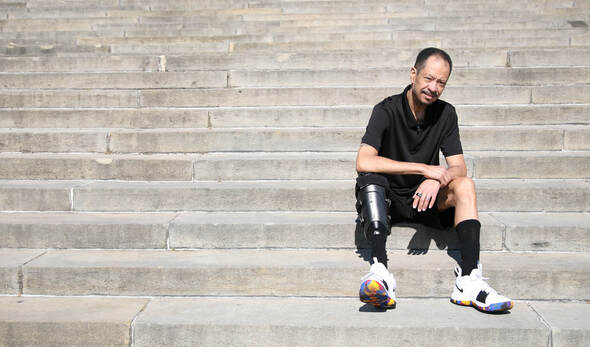View our published journal articles here:
A Prospective Assessment of an Adjustable, Immediate Fit, Transtibial Prosthesis
Dillingham T, Kenia J, Shofer F, Marschalek J. A prospective assessment of an adjustable, immediate fit, transtibial prosthesis. PM&R. 2019 Nov;11(11):1210-7.
- A group of 22 volunteers with transtibial limb loss rated the iFIT socket as significantly better in terms of comfort, stability and fit versus their conventional prosthesis (iFIT average rating was 29.3±4.51 out of 35 possible points versus 25.2±6.8 for conventional socket).
- No falls or limb ischemia were reported or noted during follow up.
- Gait biomechanics were not significantly different between devices.
- Intrasocket peak pressures were significantly lower for the iFIT prostheses overall (P = .0014), at the anterior tibia (P = .0002), and the lateral side of the residual limb (P = .013).
- This study provided preliminary evidence to support the feasibility of the iFIT system as it compared favorably to participants' conventional prostheses across all outcome measures.
Improved Self-Reported Comfort, Stability, and Limb Temperature Regulation With an Immediate Fit, Adjustable Transtibial Prosthesis
McCloskey C, Kenia J, Shofer F, Marschalek J, Dillingham TR. Improved Self-Reported Comfort, Stability, and Limb Temperature Regulation with an Immediate Fit, Adjustable Transtibial Prosthesis. Archives of rehabilitation research and clinical translation. 2020 Dec 1;2(4):100090.
LINK: Improved Self-Reported Comfort, Stability, and Limb Temperature Regulation With an Immediate Fit, Adjustable Transtibial Prosthesis - ScienceDirect
- Self-reported outcome measures for comfort, stability and fit were similar in a new group of 21 subjects with transtibial limb loss with the iFIT prosthesis rated significantly higher than conventional device (29.18 ±4.63 for the iFIT socket vs 23.82 ±6.38 for conventional device).
- Three additional participants were recruited that had never worn a prosthesis. The iFIT appeared to be an effective solution for these individuals to assist with completing therapy.
- No falls, skin breakdown or limb ischemia reported or noted during follow up.
- Subjects reported better temperature control while wearing the iFIT Prosthesis.
- These results are consistent with previous findings and further support the efficacy of an immediate fit adjustable transtibial prosthetic system.
LINK: Improved Self-Reported Comfort, Stability, and Limb Temperature Regulation With an Immediate Fit, Adjustable Transtibial Prosthesis - ScienceDirect
An immediate fit, adjustable, modular prosthetic system for addressing world-wide limb loss disability
Kenia J, Wolf B, Marschalek J, Dillingham T. An immediate fit, adjustable, modular prosthetic system for addressing world-wide limb loss disability. Archives of Rehabilitation Research and Clinical Translation. 2021 Mar 15:100120.
- The iFIT Prosthetic can be fit in austere settings, the five cases presented were all fit in one session and able to ambulate with gait training.
- Four of the five subjects fit had never worn a prosthesis; the subject that did have a prosthesis (Icecast) preferred the iFIT prosthetic as his no longer fit correctly.
- The iFIT devices are waterproof and durable enough to last years. This alleviates the need for repeated socket fabrication and adjustments, costly prospects for patients with limited resources to travel.
- iFIT sockets adjust and accommodate growth in teens.
A Prospective Assessment of an Adjustable, Immediate Fit, Subischial Transfemoral Prosthesis.
Dillingham, Timothy R., et al. "A prospective assessment of an adjustable, immediate fit, subischial transfemoral prosthesis." Archives of Rehabilitation Research and Clinical Translation (2022): 100200.
LINK: A prospective assessment of an adjustable, immediate fit, subischial transfemoral prosthesis
- A cohort of 18 persons with unilateral transfemoral limb loss tested an immediate fit, adjustable subischial prosthesis for a two-week trial.
- The test prosthesis was rated as superior to their conventional prostheses in adjustability, overall fit, prosthesis weight, sitting comfort, standing comfort and standing stability, as well as the overall satisfaction score.
- Sixty-one percent of subjects transitioned to using the adjustable socket full time.
- Thigh tissue demonstrated a high level of compressibility.
- This new subischial socket is feasible and safe for use in persons with transfemoral limb loss.
LINK: A prospective assessment of an adjustable, immediate fit, subischial transfemoral prosthesis
A prospective intervention study using immediate-fit, adjustable prostheses for persons with lower limb loss in Botswana – a feasibility and patient acceptance trial
Maikutlo Kebaetse, PhD, PT, Ntsatsi Mogorosi, BS, Jessica Kenia, MS,Frances Shofer, PhD, Timothy Dillingham, MD, MS. "A prospective intervention study using immediate-fit, adjustable prostheses for persons with lower limb loss in Botswana- a feasibility and patient acceptance trial. American Journal of Physical Medicine and Rehabilitation (2024). In press
- An immediate fit prosthesis was fit on 16 persons over 7 days.
- Thirteen persons returned for follow up 3 months later, 92% were still using the prosthesis.
- Prosthesis was rated as very comfortable and highly functional. (4.8 scores on 5 point subscales on Prosthetic
Evaluation Questionnaire. 52.3 out of 60 points overall-excellent) - These adjustable and customizable prostheses are an ideal solution for Botswana to meet the needs of persons with lower limb loss.
Other Research on Early Prosthetic Fitting:
Kurichi JE, Kwong P, Vogel WB, Xie D, Cowper Ripley D, Bates BE. Effects of prosthetic limb prescription on 3-year mortality among Veterans with lower-limb amputation. J Rehabil Res Dev. 2015;52(4):385-96. doi: 10.1682/JRRD.2014.09.0209. PMID: 26348602; PMCID: PMC4563808.
- Findings demonstrated that veterans with lower extremity amputations who received a prescription for a prosthetic limb within a year after the surgical amputation were less likely to die within three years of the surgical amputation after controlling for patient-, treatment-, and facility-level characteristics.
Miller, T.A., Paul, R., Forthofer, M. and Wurdeman, S.R., 2020. Impact of time to receipt of prosthesis on total healthcare costs 12 Months Postamputation. American journal of physical medicine & rehabilitation, 99(11), p.1026.
- Earlier receipt of a prosthesis is associated with reduced spending in the 12 mos postamputation of approximately $25,000 compared with not receiving a prosthesis.
- The results of this study suggest that not providing or delaying the provision of a prosthesis increases costs by about 25%
Miller, Taavy A., et al. "The Role of Earlier Receipt of a Lower Limb Prosthesis on Emergency Department Utilization." PM&R (2020).
- Individuals who receive a prosthesis early, within 0 to 3 months, post-LLA were 48% (odds ratio [OR] 0.52, 95% confidence interval [CI] 0.28 to 0.97) less likely to use the ED compared to those who did not receive a prosthesis.
- Individuals who experienced a fall/FRI had 2.8 (OR 2.86, 95% CI 1.23 to 6.66) times the odds of ED utilization.


